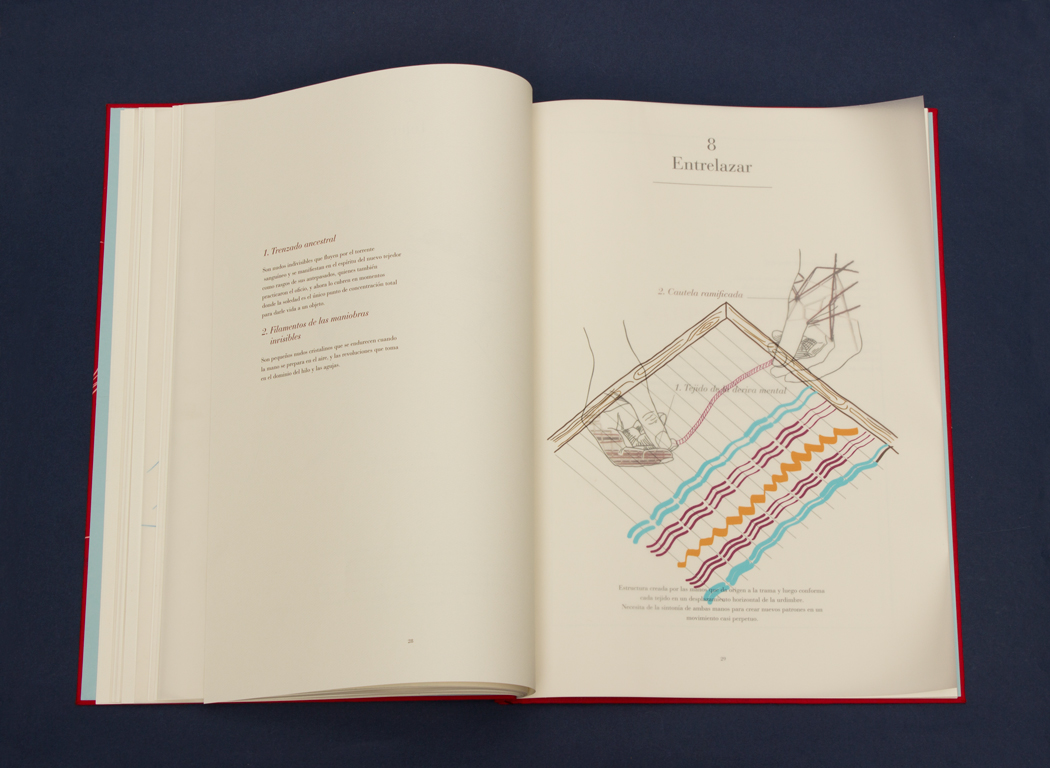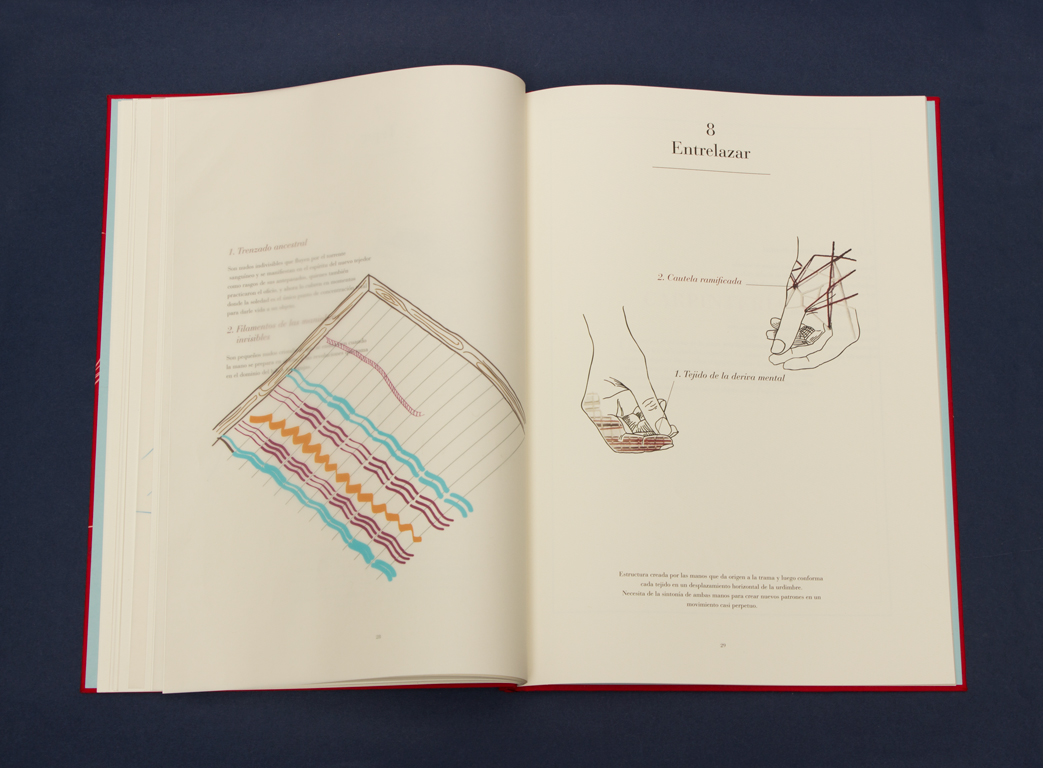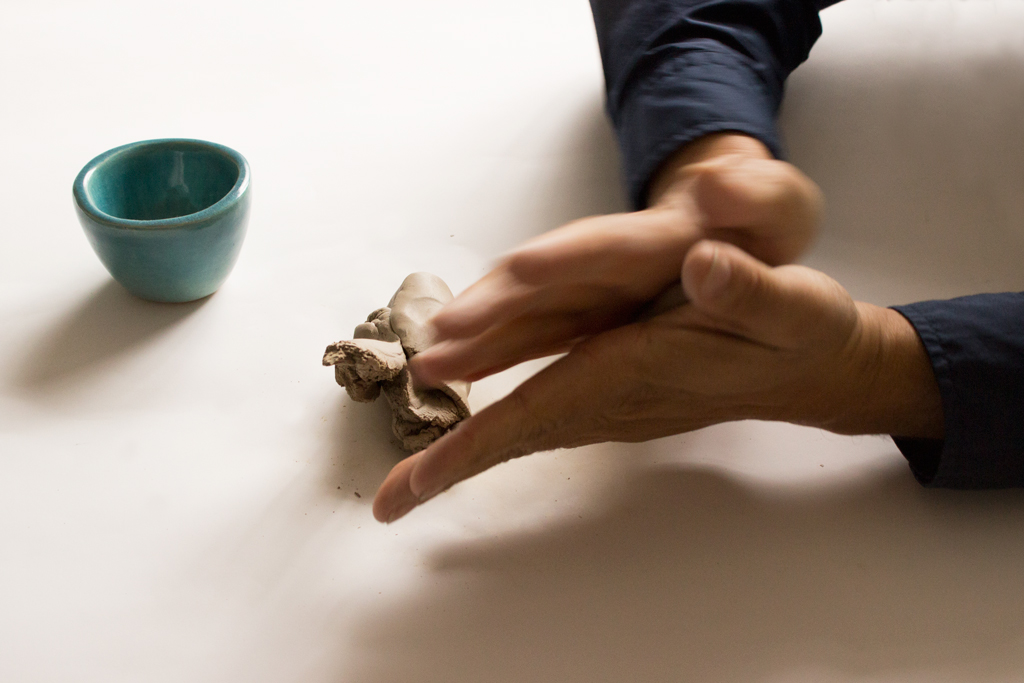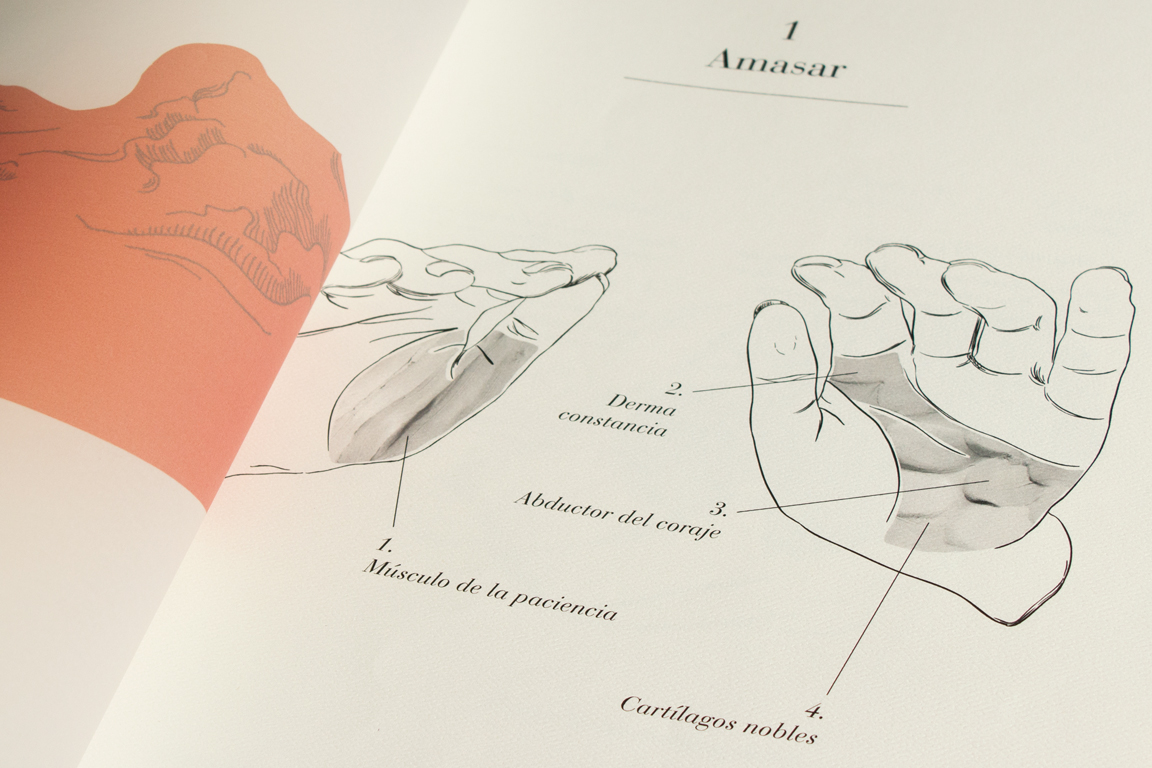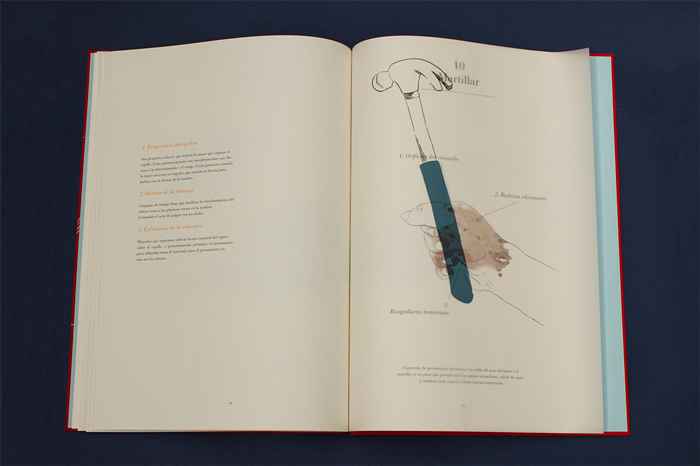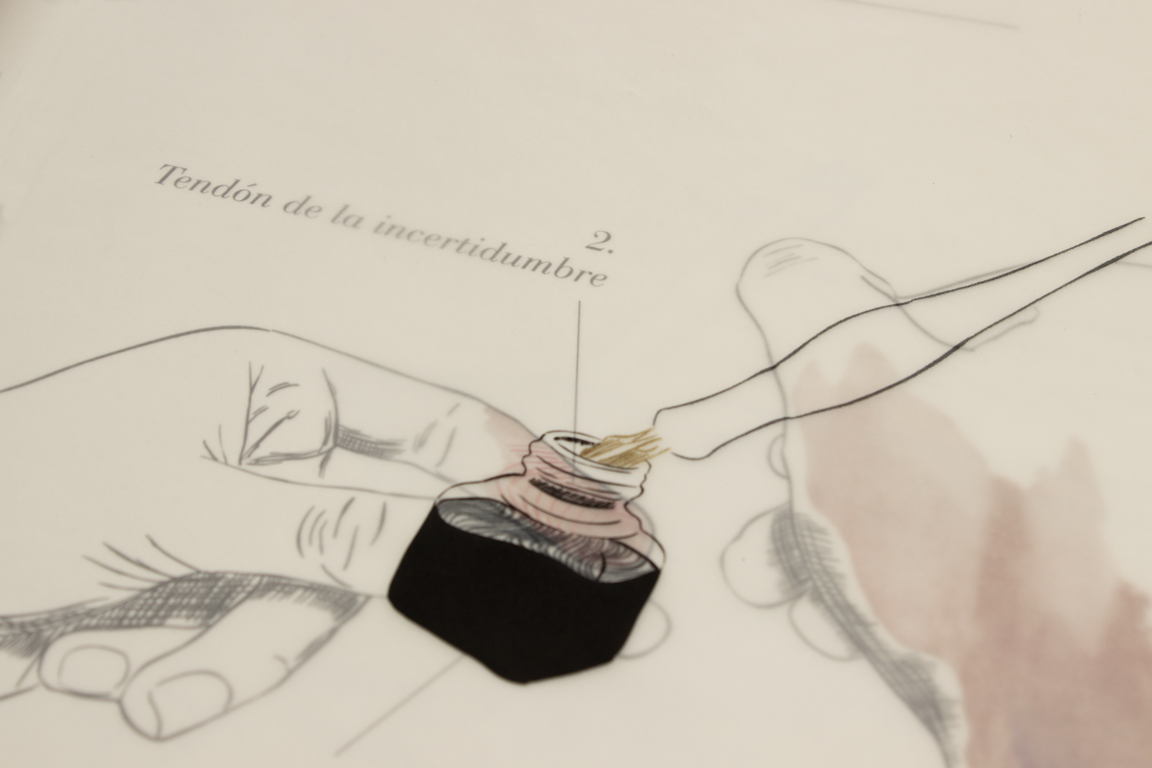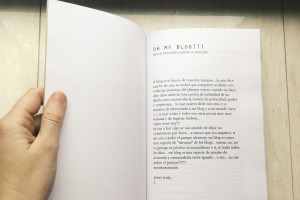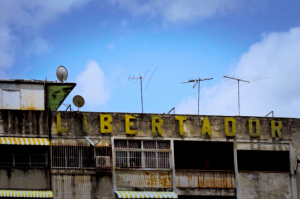Certain sensory structures allow us to recognize some of our body’s motor and cognitive actions, such as proprioception and the haptic. The haptic is related to the contact we have with other bodies and the harmony between hands, eyes, and brain. Proprioception allows us to make conscious our ownership (property) over our body when we feel our gestures, movements, and physical organs. Anatomía Poética de las Manos –»Poetic Anatomy of the Hands»– is a design project that proposes a haptic path culminating in an editorial piece, which reinterprets anatomical illustrations through poetic definitions inspired by craftsmanship.
This project was born from my personal and vocational experience with my hands: They have allowed me to create an internal dialogue with the environment, and have transcended their functional value to become an element of expression. According to Jacques Derrida [1], the hand is a personal sign that is thought and communicated through its gestures; in addition, it constructs meaning from what it interprets by touch as being cold, hot, smooth, rough, and so on. In consequence, we are able to read every tangible element through sensory responses and what they communicate to our intellect.
Although the hand is an individual universe, I found it necessary to refer to the experiences of various people whose occupations involve manual work, in order to observe how this organ is thought about in the context of different activities, tools, and materials. This allowed me to understand that each individual defines the hand with concepts linked to their trade, personality, or physical singularities. I also noticed changes in the skin and the proper behavior of the hand according to the specific movements required by each task.
According to those testimonies, the hand is a physical “trademark” of the person who creates with it. Meanwhile, feeling our hands and recognizing ourselves in the gestures of each maneuver (proprioception) are also ways of identifying with our body. The hands and their gestures are visual verbs whose poetic potential resides in their relationship with the sensations generated by contact, and in the emotional or somatic charge that emerges from the act of doing manually.
As an antecedent to the visualization of hand gestures, anatomy is a cartography that rationalizes the human body as an object of study; the organs are shown at rest, and cold dissections create a descriptive and totalizing narrative on the parts of the body. In opposition to this static image, the anatomical is employed in this project as a resource of acknowledgment and homage to our creative capacities, by means of a gestural vocabulary that proposes a meeting of the expressions of the hand in different types of labor.
From Manual Activity to the Anatomical
The process of visual and poetic construction leading up to the published piece was divided into four crafts: ceramics, writing/drawing, weaving, and carpentry. These were selected after conducting research on manual trades, and based on their relationship with the English Arts and Crafts movement–a movement characterized by principles related to craftsmanship as an honest expression of design, and in opposition to the replacement of man by mechanical serial production [2].
I approached each trade from its raw materials and examined its tactile and haptic properties with manual exercises that I later recorded with photographs. For ceramics, I cut clay and captured the formations that result from tearing away a piece of material. I also created holes and watermarks. For writing, I wanted to focus on the properties of the stroke, the texture of different substrates on paper and their reactions to water. For weaving, I began to develop textures by interlacing yarns and made tests in crochet and handloom. For carpentry, I explored unprocessed barks and trunks up to the processed forms of sawdust and laminated wood.
These texture recordings allowed me to return to the basic manual gestures of each craft (hammering, threading, brushing, modeling, etc.); I asked different individuals to recreate them with tools selected accordingly, such as needles, hammers, pens, and others. The drawings included in this Poetic Anatomy were digitally developed from the photographs; textures were digitally added later to portray non-existent internal parts of the body that refer to the poetic descriptions of each gesture.
The poetic component of this Anatomy focuses on the emotional impulses and tactile sensations that occur during each activity. These are included as indexes and written explanations. To illustrate the gesture of kneading [3], for instance, the muscle of patience appears as a part of the palm, and its concrete definition reads: “Set of thin fibers that appease the desire for a finished form; its contractions and extensions allow one to forget the pressure of time.” In this way, each gesture is presented as an anatomical drawing, and each poetic element mentioned is explained in detail on the back of the page.
The path of this piece starts with an object. For instance, in reference to the act of hammering, the hand appears with a hammer printed on a transparent surface. When the object is lifted, only the hand gesture, with its various parts, remains. Subsequently, the reader can associate and read each part of the hand with its poetic definition. This is about exposing, during the reading process, a commonplace activity that stems from contact with an object, and to turn it into an act of personal, vocational, and corporal recognition.
“Design is not only concerned with color and form. Research into how we sense color and form, or research into the senses is a critical subject of design”- Kenya Hara [4].
Although this first edition of Poetic Anatomy of the Hands focused only on the four crafts mentioned earlier, the construction of a gestural and poetic vocabulary of any given trade can generate a space for research and the rescuing of traditions in ethnic or familiar communities whose point in common might be manual creation.
A poetic anatomy consists of recognizing our capacity to generate new stimuli from what we generate with our bodies; these may be material, object or auditory representations. However, this project is an invitation for creatives to question their choice of resources, especially when they look to substitute their own hands. A raw identification should take place when the subject encounters a material and alters its composition to turn it into something that will connect with someone else–something that emerges from her thinking and is transformed by her manual gestures.
References
[1] Derrida, Jacques. “La mano de Heidegger” (Geschlecht II), trad. Marcela Rivera Hutinel, published in Nombres, Revista de Filosofía, Córdoba, year XXI, no. 26, November 2012, p. 22. Jean-Luc Nancy does not provide the full reference in the original French version.
[2] Crawford, Alan. “The Arts and Crafts movement in Britain”. Design Issues, Vol. 13, Designing the Modern Experience, 1885-1945. (primavera, 1997), pp 15-26.
[3] Restrepo, María C. «Anatomía poética de las manos, volumen 1: algunos gestos de las artes y los oficios». Bogotá, Colombia, November 2016, p. 11. Print.
[4] Hara, Kenya. “Haptic, awakening the senses”. Designing Design. Ed. Kenya Hara, Kaoru Matsuno, Hara Design Institute, Nippon Design Center. Inc. Baden, Switzerland: Lars Muller Publishers, 2007. Print.
About the author:
María Camila Restrepo Ballén (Bogotá, 1994) is a communications and product designer from Universidad de Los Andes in Bogotá. She is interested in researching art and science from a design perspective and investigating how sensorial stimuli act as channels of knowledge for the creation of new paths and experiences. She is passionate about illustration, creative direction, and editorial design.







